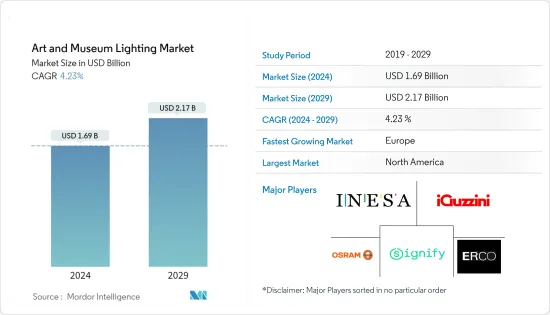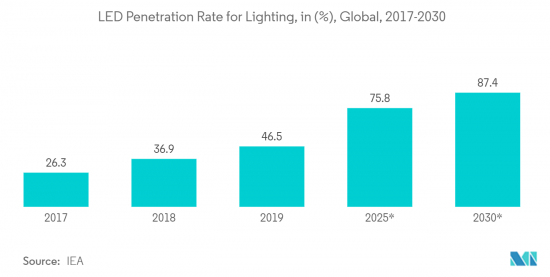PUBLISHER: Mordor Intelligence | PRODUCT CODE: 1406279

PUBLISHER: Mordor Intelligence | PRODUCT CODE: 1406279
Art & Museum Lighting - Market Share Analysis, Industry Trends & Statistics, Growth Forecasts 2024 - 2029

The Art & Museum Lighting Market size is estimated at USD 1.69 billion in 2024, and is expected to reach USD 2.17 billion by 2029, growing at a CAGR of 4.23% during the forecast period (2024-2029).
In museum lighting design, the ambient, task, focal, and decorative are all layers that contribute to the overall aesthetic of a space. Ambient layering is the general lighting of a room. This type of lighting allows one to move through space and is significantly lower than task light levels. The growing urban population across the globe has heightened concerns about the secure, reliable supply of affordable energy, environmental impacts such as greenhouse gas emissions, climate change, and loss of biodiversity, which in turn has driven the adoption of efficient sources of lighting in residential as well as in commercial buildings in cities, which is further propelling the studied market growth.
Key Highlights
- The increasing investment to refurbish or upgrade the electric lighting systems within museums and art galleries to attain significant cost savings, both in terms of energy reduction and reducing ongoing maintenance costs and growing demand for electing lighting systems with a smart control system that can respond to occupancy or user preference are the major factors driving the growth of the art & museum lighting market.
- Museums and galleries consume significant energy to maintain an internal environment to protect and preserve their collections. As per the Arup report, lighting within both exhibitions and back-of-house areas can account for 20% of the energy consumption, and to reduce the cost, most museums are using efficient luminaires.
- Furthermore, the light cast by LED lamps contains very few infrared rays and almost no ultraviolet rays, which is another advantage of using LED lamps for the museum's lighting system. The fragile artwork no longer requires filters to preserve it from damaging infrared or ultraviolet beams, which enhances the visitor's visual experience.
- Also, a survey conducted at the Manchester Museum revealed that 50% of the total cost of energy consumption was attributable to the museum's lighting system. When the museum decided to replace its fluorescent tubes with LED lamps and affix motion sensors to the luminaires throughout its establishment, it reduced its consumption by around 89%.
- Moreover, the museums and art galleries' most significant challenge is to balance the energy savings and lighting quality of the displays as expected by the artist. Most of the time, the lure of substantial energy savings can sometimes lead to compromised lighting quality. Hence, most market vendors provide comprehensive lighting design services, from initial strategic advice and concept development to construction documents and on-site support.
- Additionally, the Russia-Ukraine conflict might cause extra disruptions and affect the supply chains of semiconductors, leading to further increases in the prices of electronics. Overall, the impact of the conflict on the electronics industry is expected to be significant. This would hamper the production of smart lighting products.
Art & Museum Lighting Market Trends
LED Segment is Expected to Drive the Growth of the Market
- Lighting up museums and art galleries well is crucial. Light helps draw attention to artwork while preventing damage to the work itself. These two imperatives often conflict, as exposing artwork to a source of intense light can periodically affect its quality. According to IEA, as more and more countries are getting close to phasing out conventional bulbs, LEDs are continuing their march to the top of the Market. The penetration rate of LEDs into the global lighting market is expected to reach a penetration of 76% in 2025 and a further 87.4% in 2030.
- Consequently, there is a need for a lighting solution that enables optimal visual appreciation of the art and ensures that its characteristics are not tainted. As a result, LED luminaires have emerged as the preferred lighting solution in museums and art galleries. Light-emitting diode (LED) lamps are increasingly replacing the incandescent and fluorescent lamps used by museums and art galleries for decades. Of all the advantages of the LED, its duration is the most significant. LEDs can have a 25,000+ hours lifetime compared to their traditional counterparts, translating to approximately ten years of museum and art gallery visiting hours.
- The growing consumer awareness about the environment and the durability of electric lights, along with the government mandates for energy efficiency, are the drivers for the increasing adoption of LEDs. Modern LED lighting solutions are advancing rapidly as they deliver significant energy-saving potential. Increasing efficacy, optimized luminaire design, and flexible lighting control enable enhanced performance at a lower cost for different lighting and traffic conditions.
- The interior artificial light sources of the museum and art galleries include incandescent, halogen, fiber optics, fluorescent, cold cathode, and LEDs. Incandescent lamps are generally used for ambient and accent lighting with track luminaires. However, by discontinuing most halogen light sources, most art galleries replaced their current stock of gallery luminaires with new LED luminaires without the need to change their existing electrical infrastructure and lighting controls. LED luminaires have also reduced electric costs significantly.
- Moreover, LED lighting technology is very energy-efficient and can drastically impact the future of lighting in the United States. The widespread adoption of LED lighting has a significant potential impact on American energy savings. By 2035, it's predicted that most lighting installations will be LED-based. According to US DOE, Energy savings from LED lighting might reach 569 TWh annually by 2035, equivalent to the yearly energy production of over 921,000-megawatt power plants.

Europe is Expected to Experience Significant Growth
- Due to growing environmental concerns and the adoption of light-emitting diode (LED) lighting systems across industries, the EU market is anticipated to dominate the LED lighting market with a sizeable share. LED-based lights are preferable to conventional lighting technologies because they are more energy-efficient, have a longer lifespan, and require less electricity to operate. Europe is one of the world's most inventive lighting marketplaces as the lighting industry transitions to solid-state lighting and LED sources.
- In order to boost consumer adoption of LED products and phase out older, less efficient technologies, the regional governments are also offering subsidies and incentives. This will enhance the overall efficiency of the European lighting industry. For instance, EU Green Lights funded a EUR100M Subsidy for Italian Olive Millers in October 2022. According to the Italian Ministry of Agriculture, Food, and Forestry, the new subsidies will fund initiatives that use less energy and have a minor environmental impact.
- At COP 26, the EU committed to reducing emissions by at least 55% by 2030 to become the first area to achieve climate neutrality by 2050. As a result, the move to phase out fluorescent lamps is growing in importance and can be done for a direct societal benefit. With the United Nations Minamata Convention on Mercury, such decisions will assist the EU in accelerating the switch to energy-efficient, clean LED lighting.
- LED illumination enables operating optimization without sacrificing viewing pleasure or art preservation. Since Europe is home to seventeen of the largest museums in the world-seven of them are in London, three are in Paris, Madrid, and Barcelona, two are in Rome, and one in each in Florence and Rome-it presents a substantial growth opportunity for the LED market. Such factors can create a demand for LED lighting in public places such as Art and Museums.
- With The rise in the usage of LEDs and the stricter rules for the marine industry concerning safety lights, the growing demand for energy-efficient lighting will drive the Market. For instance, in November 2022, the European Commission recently announced an additional EUR 10 million for a project to lower the greenhouse gas (GHG) emissions from international shipping in the margins of COP27.
- Additionally, the changing regulations for energy efficiency requirements and other factors for almost all lamps sold in Europe, such as bulb lifetime and warm-up time, are anticipated to fuel the Market. According to the latest regulation, most halogen lamps and traditional fluorescent tube lighting will be phased out from September 2023 onwards.
Art & Museum Lighting Industry Overview
The art and museum lighting market is competitive and is dominated by a few significant players like Signify NV, Osram Licht AG, ERCO GmbH, Inesa Lighting (Pty) Ltd, and iGuzzini illuminazione S.p.A. These significant players, with a prominent share in the market, are concentrating on expanding their customer base across foreign countries. These corporations leverage strategic collaborative initiatives to increase their market share and profitability.
In November 2022, Nanoleaf announced the addition of four new Matter-compatible smart bulbs and light strips under its Essential Smart Lighting line product range. Among these new products, the Thread-enabled LED lights launched in Q1 of 2023 and include a light strip and A 19, BR 30, and GU 10 bulbs, making them some of the first to support Matter directly without a bridge.
In June 2022, Cree LED launched XlampElement G (XE-G) LEDs that deliver a new performance class with unpaired light output and efficiency in a small form factor. The XE-G LED family of products has been recognized by EdisonReportas a "LightFair Top 10 MUST SEE" product on display at Cree LED's booth 3007 is a stunning, 8-foot periodic table showcasing all 17 colors and three white options available in the comprehensive XE-G LED family.
Additional Benefits:
- The market estimate (ME) sheet in Excel format
- 3 months of analyst support
TABLE OF CONTENTS
1 INTRODUCTION
- 1.1 Study Assumptions and Market Definition
- 1.2 Scope of the Study
2 RESEARCH METHODOLOGY
3 EXECUTIVE SUMMARY
4 MARKET INSIGHT
- 4.1 Market Overview
- 4.2 Industry Attractiveness - Porter's Five Forces Analysis
- 4.2.1 Bargaining Power of Suppliers
- 4.2.2 Bargaining Power of Consumers
- 4.2.3 Threat of New Entrants
- 4.2.4 Threat of Substitute Products
- 4.2.5 Intensity of Competitive Rivalry
- 4.3 Impact of Macroeconomic Trends
5 MARKET DYNAMICS
- 5.1 Market Drivers
- 5.1.1 Increasing Adoption of LED Luminaires in Museum and Art Galleries
- 5.1.2 Growing Demand for Electing Lighting System with a Smart Control System
- 5.2 Market Restraints
- 5.2.1 Lack of Awareness about the Advantages of the LED Lights
6 MARKET SEGMENTATION
- 6.1 By Type
- 6.1.1 LED
- 6.1.2 Non-LED
- 6.2 By Application
- 6.2.1 Indoor
- 6.2.2 Outdoor
- 6.3 By Geography
- 6.3.1 North America
- 6.3.2 Asia Pacific
- 6.3.3 Europe
- 6.3.4 Middle East & Africa
7 COMPETITIVE LANDSCAPE
- 7.1 Vendor Market Share
- 7.2 Company Profiles
- 7.2.1 Signify NV
- 7.2.2 OSRAM Licht AG
- 7.2.3 ERCO GmbH
- 7.2.4 Inesa Lighting (Pty) Ltd.
- 7.2.5 iGuzzini illuminazione S.p.A
- 7.2.6 BEGA Gantenbrink-Leuchten
- 7.2.7 Lumenpulse Group
- 7.2.8 Acuity Brands Inc.
- 7.2.9 Targetti Sankey S.p.A.
- 7.2.10 Feilo Sylvania Group
8 INVESTMENT ANALYSIS
9 FUTURE OF THE MARKET




